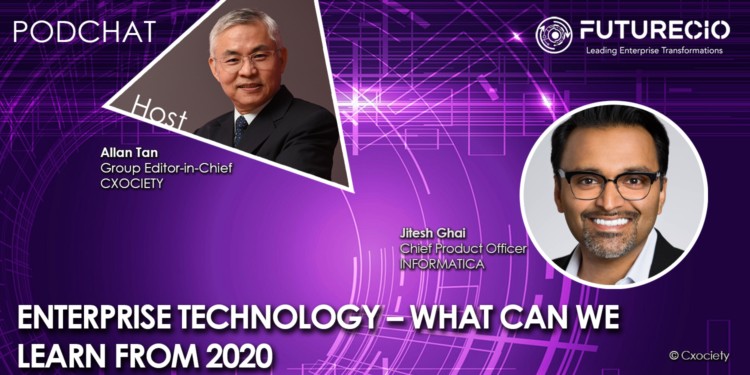An integration platform is a set of automation tools for connecting applications deployed in different environments. It is not farfetched to imagine that as we move deeper into best-of-breed and multi-cloud, the technologies available to organisations as well as the environments from which to fulfil business needs, will grow in complexity alongside.
To complicate this is COVID-19 which threw a spanner on how organisations plan and execute their strategies in 2020. With no real-end in sight – just a glimmer of hope – for 2021, how should leadership including the CIO move forward?
FutureCIO spoke to Jitesh Ghai, chief product officer, Informatica, to get his opinion on the evolving data integration landscape in Asia.
Data integration in Asia
Ghai noted a steady progression towards the modernisation of data and the use of analytics in the region. He commented that enterprises are modernising in the cloud to build resiliency and adaptability.
“COVID-19 has rapidly accelerated the modernisation trend. It has also resulted in a broad-based appreciation of the need for adaptability, resilience and agility in a platform-as-a-service offering. It’s a fact-based way to run your business, and this has accelerated in a highly variable environment,” he added.
Ghai confirmed that digital transformation initiatives got a boost with the COVID-19 pandemic. “From that standpoint, nothing has stopped. Frankly, things have accelerated materially. Where we see significant acceleration even beyond that, for data transformation, is bringing all that data and modernising their infrastructure, toward a cloud-first, cloud-native strategy,” he added.
Platform for building trust and adoption
He also opined that the cloud offers the better platform to facilitate trust among the various users and owners of data. And key to building this trust is governance and privacy.
“If you’re going to be more data-driven and you’re going to move more data into the cloud for all its benefits, you need to ensure governance and privacy of that data,” he elaborated.
Enterprises are recognizing that to modernise, to deliver the successful digital transformations, they need to be data-driven. But any effort to digitise will require user [people] participation.
“They are recognising that their people need to be more data-driven. A key enabler is not just through technology and tooling, access and moving data, and ensuring its quality, but ensuring that data is accessible by all data consumers within an enterprise,” he added.
He acknowledged such an effort presents a complex problem given the varied skillset across deeply technical users to non-technical business users.
“To enable that, we are automating data management to ensure easy access to all types of users with varied skillsets. We are applying AI and ML to make data management intelligent an make it easily accessible and consumable to all users within an enterprise. That is a key focus for organisations as they become more data-driven in 2020, and that continues to accelerate going into 2021,” Ghai commented.
Eroding misconceptions
Asked about persistent misconceptions around data and data management, he highlighted some encouraging trends particularly around the role of data strategy executives.
“We’re seeing Chief Data Officers, Chief Analytics Officers with key charters. Some of these roles report into the CFO, the CIO and sometimes the CMO, and directly to the CEO,” he observed.
Planning for 2021
“More importantly, going into 2021, we will begin to see the culture change needed across people, process, and AI-powered technology, to make CDOs and data strategy executives more successful. To enable the business to meet its top priorities through data-driven transformations. “
For leadership looking to executive their data-strategy he cautioned that being data-driven is an exercise in moving from treating data tactically, to first start understanding what your business priorities are.
Identify what are the data workstreams in those top priorities, and for those data workstreams, what are the essential data capabilities needed. In doing so, understand and formulate what the data strategy be. Because data is more strategic than ever, all organisations should have a comprehensive strategy.
“And what are the people, processes and technology needed, the necessary change management across culture, processes, and people, to enable them to be more data-driven, and modernise to the cloud. To build out AI and ML to support their business objectives,” he concluded.
Click on the podchat player to listen to Ghai’s views.
- How has the pandemic shaped the demand for enterprises technology in Asia Pacific?
- Among technology projects originally planned in 2019 for deploying in 2020, what has continued, what has stopped altogether (or slowed down)?
- Focus on integration platforms: How do you define an integration platform and is it restricted to an as-a-service offering or can it live as a hybrid model?
- If we take a general sweep of the data integration platform market, what remains a limitation for the market in 2020?
- Emerging technologies like automation and AI continue to mature. As CIOs and CTOs start to plan their 2021 strategies (with and without COVID-19), do they need to include a data integration platform strategy in there?
- Among non-tech users, including leaders, what remains a misconception as regards data and data management?
- What is your advice to the business leaders as regards to how they fulfil their data-driven aspirations?





